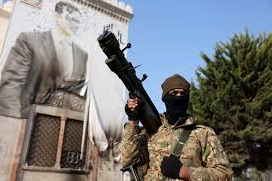How It Happened: 2 Seismic Weeks That Toppled Syria’s Government

The Syrian government, led by the Assad family for over five decades, experienced an abrupt and unprecedented downfall in late 2023. What began as a strategic rebel offensive in the northwest quickly escalated into a sweeping campaign, dismantling the regime’s power structure within mere days. This article examines the timeline of events, the rapid territorial gains of the rebels, and the broader implications of this seismic shift in Middle Eastern geopolitics.

A Two-Week Collapse of Syria’s Government
The Rebel Offensive Begins (November 27)
On November 27, armed opposition groups led by Hayat Tahrir al-Sham (HTS) initiated a large-scale attack in northwestern Syria. These forces rapidly seized over 15 villages in Aleppo province, catching the Syrian military off guard. HTS, a rebranded former affiliate of al-Qaida, spearheaded the operation, aiming to push back government forces.
Key Developments
- Tactical Surprise: Rebels exploited weakened government defenses.
- Turkey’s Role: Turkey supported the limited offensive, citing retaliation for earlier attacks by Syrian forces.
- Initial Success: The opposition quickly overran critical villages, creating momentum.
| Date | Event | Outcome |
|---|---|---|
| November 27 | Rebel offensive begins | Over 15 villages were captured in Aleppo province |
Aleppo Falls Amid Escalating Advances (November 28-30)
Within days, the insurgents expanded their reach into Idlib and Aleppo provinces, overcoming minimal resistance. By November 29, rebels entered Aleppo city, Syria’s largest, marking their return after years of government control. On November 30, they solidified their hold over Aleppo, capturing strategic locations like the international airport.
Strategic Gains
- Control Over Aleppo: A vital economic hub returned to opposition hands.
- Minimal Resistance: The Syrian army retreated, leaving behind key areas.
| Date | Event | Outcome |
|---|---|---|
| November 29 | Rebels enter Aleppo city | Government retreats |
| November 30 | Aleppo falls to the opposition | Airport and Citadel seized |
Government Struggles to Retaliate (December 1-4)
Faced with staggering losses, the Syrian military attempted a counteroffensive with limited support from its allies. Iran and Russia, preoccupied with regional challenges, offered only nominal assistance. Meanwhile, the rebels continued their southward march, capturing key territories in Hama province.
Failed Counteroffensive
- Weakened Allies: Hezbollah, Iran, and Russia provided minimal reinforcements.
- Strategic Challenges: The government failed to regain significant ground.
| Date | Event | Outcome |
|---|---|---|
| December 1-4 | Government counterattacks | Limited success in reclaiming territory |
Damascus Encircled, Homs Falls (December 5-7)
The insurgents captured Hama on December 5 and quickly advanced toward Homs. By December 7, the rebels controlled Homs, a gateway to Damascus and home to vital infrastructure, including an oil refinery. With Damascus surrounded, the government’s grip on power all but collapsed.
Critical Developments
- Loss of Homs: Severed links between Damascus and loyalist coastal regions.
- Encirclement of Capital: Opposition forces began the final stage of their offensive.
| Date | Event | Outcome |
|---|---|---|
| December 5 | Rebels capture Hama | Celebrations in Assi Square |
| December 7 | Homs falls to opposition forces | Gateway to Damascus under rebel control |
The End of Assad’s Rule (December 8)
On December 8, opposition forces declared victory after taking control of Damascus. President Bashar Assad fled to Moscow, reportedly seeking asylum with his family. The transitional government announced its willingness to negotiate for a peaceful political transition, marking the end of the Assad era.
Aftermath
- Victory Declared: HTS leader Abu Mohammed al-Golani proclaimed a historic triumph.
- Political Transition: The United Nations began efforts to broker a power-sharing agreement.
| Date | Event | Outcome |
|---|---|---|
| December 8 | Damascus falls, Assad flees | End of the Assad regime |
The Broader Implications of Assad’s Fall
The swift collapse of the Assad regime brings a mix of opportunities and challenges for Syria and the region.
- Political Uncertainty: Establishing a stable government will require extensive negotiations and international support.
- Humanitarian Impact: With millions displaced, rebuilding Syria’s infrastructure and society remains monumental.
- Geopolitical Repercussions: Regional powers like Turkey, Iran, and Russia will vie for influence in the country’s future.

Read more: Still Just Concepts?’: NBC’s Kristen Welker Presses Trump For Details On Health Care Plan
FAQs
What led to the collapse of Assad’s government?
The collapse was triggered by a large-scale rebel offensive that rapidly overran key cities, coupled with weakened support from Assad’s allies.
Who led the rebel offensive?
Hayat Tahrir al-Sham (HTS), a rebranded former al-Qaida affiliate, led the offensive.
What role did international actors play?
Turkey supported the rebels, while Russia and Iran offered limited aid to the Syrian government due to other priorities.
What is the current state of Syria?
Syria is transitioning to a post-Assad era, with efforts underway to establish a new political framework.
How did Damascus fall so quickly?
The Syrian army retreated under pressure, leaving the capital vulnerable to the insurgents’ advance.
What are the challenges facing Syria now?
Syria faces political instability, a humanitarian crisis, and the challenge of rebuilding after years of conflict.
Conclusion
The fall of the Assad government marks a pivotal moment in Syria’s history, bringing an end to decades of authoritarian rule. While the swift collapse highlights the regime’s vulnerabilities, the road to recovery will be long and fraught with challenges. The coming months will determine whether Syria can achieve lasting peace and stability in the wake of these seismic events.






